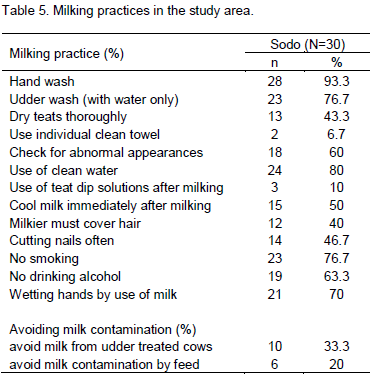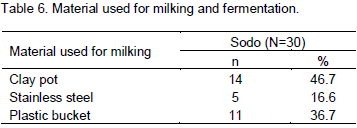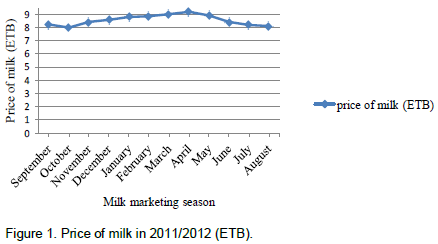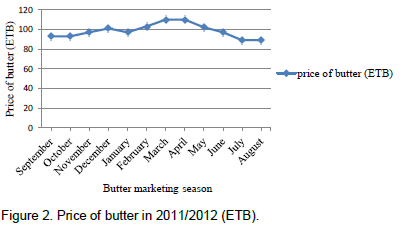ABSTRACT
A study was conducted to assess knowledge gap and identify constraints on production and consumption of standardized dairy products. Only 20, 10, 16.7, 3.3 and 6.7% had knowledge about standardized dairy products, hazard consequent of using substandard dairy products, proper standards during milk production, hazard analysis critical control point system and what to check during shopping labeled dairy products, respectively. All respondents had not consumed ghee, milk powder, ice cream and cream. About 77, 7, 60 and 67% were wash udder, use towel, check abnormal appearances, and not avoid milk from udder treated cows, respectively. Different sources of contamination of milk were less dangerous (43.3%) and not dangerous at all (30%). Milking (100%), milk handling (90%), milk processing (100%), milk marketing (90%) were done by female. During wet season, price of milk and butter were 8.00 ETB per liter and 93 ETB per Kg, respectively. During dry season, price of milk and butter were 9.00 ETB per liter and 106 ETB per Kg, respectively. Thus, knowledge was poor on standardized dairy products and awareness creation, supply of value added milk products and improved milk production technologies were needed.
Key words: Knowledge gap, standardized dairy products, production, consumption, gender role.
The livestock subsector plays a vital role as source of food, income, services and foreign exchange to the Ethiopian economy, and contributes to 12 and 33% of the total and agricultural GDP, respectively, and accounts for 12 to 15% of the total export earnings, second in order of importance (Ayele et al., 2003).
Among the 20 major food and agricultural commodities ranked by value in 2005, whole fresh cow milk is ranked third. Milk production in the same year was estimated at 1.5 million tonnes which is equivalent to USD 398.9 million (FAOSTAT, 2007). For years or decades Ethiopia ranked first in cattle population in Africa, but the dairy industry is not developed even as compared to east African countries like Kenya, Uganda and Tanzania. Regarding dairy production, the national milk production remains among the lowest in the world, even by African standards (Zegeye, 2003).
Although, many efforts were made towards dairy development and various research projects have been undertaken in some parts of the country, the outcome and impact have not been satisfactory. Planners should consider the relative efficiency of alternative milk marketing systems in terms of costs and marketing margins, product hygiene and quality, range and stability of services offered and stability of producers and consumer prices. To do so, policy makers, development organizations and private investors are in need of information of different aspects of the production system of the specific area, potentials and constraints. Therefore, this study was conducted to support dairy development in the region through assessment of knowledge gap and collection and documentation of information on the current practices and challenges on milk production and consumption.
Description of the study area
The study was conducted at Kokate Kebele (rural area) and Wolayta Soddo town (urban area) of Wolayta zone, Southern Ethiopia. The Kebele and town were purposefully selected due to high milk marketing and consumption activities in Soddo town and Kokate kebele is its main milk shed. Wolayta Soddo town is located at a distance of 330 km south of the capital, Addis Ababa where as Kokate kebele is located at a distance of about 6 km north of the capital, Wolayta Soddo.
Selection of respondents and data collection
A total of 30 milk and milk products producer households at Kokate kebele, 30 milk collector households (café and restaurants) and 30 consumers at Wolayta Soddo town were selected based on milk production, collection (marketing) and consumption experiences. Therefore a total of 90 respondents were selected, interviewed and were included in the study.
Data was collected by using a pre tested semi structured questionnaire in February to April, 2011. Enumerators were selected from Areka Agricultural Research Center, Animal Science Research Case Team and orientation was given to brief them the ways of data collection. Then formal surveys were conducted by interviewing the household heads of the selected milk producing households (farmers), collectors (hotels and cafes), milk and milk products consumers.
Data analysis
The data collected were analyzed using SPSS (version 16). Descriptive statistics such as mean and percentages were used to summarize data as required.
Knowledge level on standardized dairy products
Ethiopian quality and standards authority had developed milk and dairy products standards in the year 2001.
These standards were then revised in 2005 to be harmonized with the common market for Eastern and Southern Africa accepted standards. However, only 20, 10, 16.7, 3.3 and 6.7% of the respondents had knowledge about standardized dairy products, hazard consequent of using substandard dairy products, proper standards during milk production, hazard analysis critical control point (HACCP) system and what to check during shopping labeled dairy products, respectively (Table 1). About 50% of the respondents had traditional dairy products standards in their area which is much higher than traditional dairy products standards (20%) in Ada,a and Lume districts of East Shewa zone of Ethiopia (Bilatu et al., 2013).
Availability and consumption trend of dairy products
As indicated in Table 2, about 70, 33, 30, 10 and 33% of respondents consumed whole fresh milk, homemade fermented milk, buttermilk, cheese and butter, respectively. However respondents consumed ghee, milk powder, ice cream and cream were nil due to unavailability. The study indicated that the consumption of milk and milk products was directly related with availability of milk and milk products. Inconsistent with the present findings, Bilatu et al. (2013) reported that standardized milk imported or locally produced such as skim milk, powdered milk and ice cream are prevalent in urban areas of Ada,a and Lume districts of East Shewa zone, Ethiopia. In close agreement with the present findings, Getachew and Gashaw (2001) indicated that about 68% of the total milk produced in rural Ethiopia is used for household consumption in the form of fresh milk, butter, cheese and yogurt. Moreover, Belete et al. (2010) reported that dairy products consumed in the household are fresh whole milk, fermented (sour) milk (locally called ‘ergo’), local cheese (ayib) and buttermilk (wogemit or arera) in amhara region of Fogera woreda, Ethiopia.

In the present study, majority of respondents in Sodo town consumed whole fresh milk which is not in agreement with Ayantu (2006) in the Delbo watershed of Welayta zone and O’Connor and Zinash (1990) in Centeral highlands of Ethiopia. They observed that larger part of the produced milk processed into various products such as butter, soft cheese, fermented milk and buttermilk. In the present findings, large proportion of respondents consumed whole fresh milk might be due to large number of producers sold whole fresh milk due to short distance to urban center, access to markets and lack of traditional taboo that restricts selling of whole fresh milk (Belete et al., 2010).
In the study area, dairy farmers sold whole fresh milk for hotels and café whereas butter milk and butter were sold in the local open markets. About 60 and 47% of purchasing consumers were not concerned at all about safety of dairy products when purchased from open markets and producers, respectively (Table 3). To assess the perception about danger of different sources of milk contamination, consumers responded less dangerous, not dangerous, somewhat dangerous, dangerous, very dangerous were 43.3, 30, 13.3, 6.7 and 6.7%, respectively (Table 4). All respondents indicated that priority of whole milk consumption was given for children less than 3 years of age and male household head. Among the family members, children less than 3 years of age (50%) was the most vulnerable to dairy born food illness which is in agreement with Bilatu et al. (2013).
Milking practices
Milking practice is one of the most important criteria for hygienic milk production. About 93% washed their hand before milking, 76.6% washed udder with water only, 43.3% washed and dried teats with a warm sanitizing solution, 6.7% used individual clean towel, 63.3% checked udder and foremilk for mastitis/udder inflammation, 60% checked for abnormal appearances in milk, 80% used clean water, 10% used teat dip solutions after milking, 50% cooled milk immediately after milking, 40% milkier covered hair, 46.7% cutting nails often, 76.7% had no smoked, 63.3% had no dinked alcohol, 50% avoided spitting and 70% had wet hands by use of milk to facilitate milk letdown. About 67 and 80% were not avoided milk from udder treated cows and not avoided milk contamination by feed during milking, respectively (Table 5). Consistent with the present study, Zelalem and Faye (2006) reported that dairy processing in the country is basically limited to smallholder level and hygienic qualities of products are generally poor. The same authors also reported that about 52% of smallholder producers and 58% of large-scale producers used common towel to clean the udder and 45% did not treat milk before consumption which was in close agreement with the present findings. Contrary to the present findings, Zelalem and Faye (2006) reported that all producers do not use clean water to clean the udder and other milk utensils.

Milking and fermentation materials
Proper milk handling practice is a prerequisite prior to consumption, marketing and/or further processing purposes and therefore utensils that are used in milking, fermenting, churning, or consumption of milk must be properly and easily cleaned (Anteneh et al., 2008). About 47, 37 and 16% used clay pot, plastic bucket and stainless steel as a milking material, respectively. None of the respondents reported wooden container, metallic container and calabash (qil) as a milking and fermenting material (Table 6). In agreement with the present study, Sintayehu et al. (2008) reported that majority of dairy producers at shashmene- Dilla areas of the same region used traditional churning material made from clay pot. This observation is also similar to the case for the central highlands where clay pot churn is mostly used (O’Mahoney and Peter, 1987), whereas it is different from the case of East Wollega where 91% of women used gourd for churning and storage of milk (Alganesh, 2002).

The role of gender in milking and post-harvest activities
In the study area, gender has a great role in milking and post harvest activities. According to the respondents, milking (100%), milk handling (90%), milk processing (100%), milk marketing (90%) were done by female household members (Table 7). In agreement with the present findings, Ayantu (2006) reported that milking and milk processing are done by female and men do not process milk and/or involve in the marketing of milk and milk products in Delbo watershed of Wolayta zone. Alganesh (2002) also reported that in Wollega area, women exclusively do milking and processing of milk into different products.
Milk and milk products marketing
All producers in the milk shed of Sodo town who own crossbred cows participated in fluid milk marketing. The dominant informal milk marketing was based on contractual agreement between the producer and the client at Sodo. Prices were negotiated and the milk was delivered on a daily basis. The producer was paid at the end of the month. During the wet season (June to November), low price of milk (8.00 Ethiopian Birr (ETB) per liter on average) and butter (93 ETB per Kg on average) was due to feed availability. On the other hand, during dry season (December to May), high price of milk (9.00 ETB per liter on average) and butter (106 ETB per Kg on average) was due to scarcity of feed for dairy animals and also in association with availability of some public festivals (Figures 1 and 2). In agreement with the present findings, Anteneh et al. (2008) reported that during the wet season, the price of milk and milk products are lower due to better roughage supply to dairy cattle, resulting in higher milk yields and higher supply of milk and the contrary is true for dry season at Shashmene-Dilla areas of Ethiopia.


cream were nil due to unavailability of the products. Majority of purchasing consumers were not concerned at all about safety of dairy products when purchased from open markets. Milking practices such as use of teat dip solutions after milking and use individual clean towel were very poor. Almost all of milking and post harvest activities were done by female house hold members. Price of milk and milk products was directly depends on price and availability of feed.
Therefore, awareness creation, supply of value added milk products, milk production technologies, introduction of year-round feed production and conservation technologies were needed to improve the production and consumption trend of milk and dairy products.
The author(s) have not declared any conflict of interests.
We appreciate support from Eastern Africa Agricultural Productivity Project (EAAPP) with an equipment loan from Areka Agricultural Research Center. The terms of this arrangement have been reviewed and approved by the EAAPP and Southern Agricultural Research Institute with its policy on objectivity in research.
REFERENCES
|
Alganesh T (2002). Traditional milk and milk products handling practices and raw milk quality in eastern Wollega. MSc Thesis. Alemaya University. Ethiopia. P. 108. |
|
|
|
Ayantu M (2006). Women,s role on production, processing and marketing of milk and milk products in Delbo watershed of Wolayta Zone, Ethiopia. MSc Thesis. Hawasa University. Ethiopia pp. 45-48. |
|
|
|
Ayele S, Assegid W, Jabbar MA, Ahmed MM, Belachew H (2003). Livestock marketing in Ethiopia: A review of structure, performance and development initiatives. Socio-economics and Policy Research Working ILRI (International Livestock Research Institute), Nairobi, Kenya. 52:35. |
|
|
|
Bilatu A, Kassahun M, Asnaku F, Kassech M (2013). Assessment of knowledge gap and factors affecting consumption of dairy Products in Ada,a and Lume districts of East Showa Zone, Ethiopia. Afr. J. Food Sci. Technol. 3(9):2001-2010. |
|
|
|
Belete A, Azage T, Fekadu B, Berhanu G (2010). Cattle milk and meat production and marketing systems and opportunities for market-orientation in Fogera woreda, Amhara region, Ethiopia. IPMS (Improving Productivity and Market Success) of Ethiopian Farmers Project Working ILRI (International Livestock Research Institute), Nairobi, Kenya. 19:65. |
|
|
|
FAOSTAT (Food and Agricultural Organization of the United Nations Statistics) (2007). Online database on food and agricultural products and producers. |
|
|
|
Getachew F, Gashaw G (2001). The Ethiopian dairy development policy: A draft policy document. Ministry of Agriculture/AFRDRD/AFRDT Food and Agriculture Organization of the United Nations/SSFF. Addis Ababa, Ethiopia. |
|
|
|
O'Connor CB, Zinash Z (1990). The production and utilization of milk and milk products by smallholders in the Eastern Region of Shoa, Ethiopia. Proceedings of the XXIII International Dairy Congress, Brief communications and posters Montreal, Canada 1:12. |
|
|
|
O, Mahoney F, Peters J (1987). Options for small holder milk processing. World Anim. Rev. 62:16030. |
|
|
|
Sintayehu Y, Fekadu B, Azage T, Berhanu G (2008). Dairy production, processing and marketing systems of Shashmene-Dilla area, South Ethiopia. P. 13. |
|
|
|
SPSS (Statistical Procedures for Social Sciences) (2001). SPSS BI Survey Tips. Statistical Procedures for Social Sciences (SPSS) INC. Chicaco, USA. |
|
|
|
Zegeye Y (2003). Imperative and challenges of dairy production, processing and marketing in Ethiopia. In: Jobre Y and Gebru G (eds), Challenges and opportunities of livestock marketing in Ethiopia. Proceedings of the 10th annual conference of the Ethiopian Society of Animal Production (ESAP) held in Addis Ababa, Ethiopia, 22–24 August 2002. ESAP, Addis Ababa, Ethiopia. pp. 61–67. |
|
|
|
Zelalem Y, Faye B (2006). Handling and microbial load of cow's milk and Irgo—fermented milk collected from different shops and producers in central highlands of Ethiopia. Ethiop. J. Anim. Prod. 6(2):7–82. |